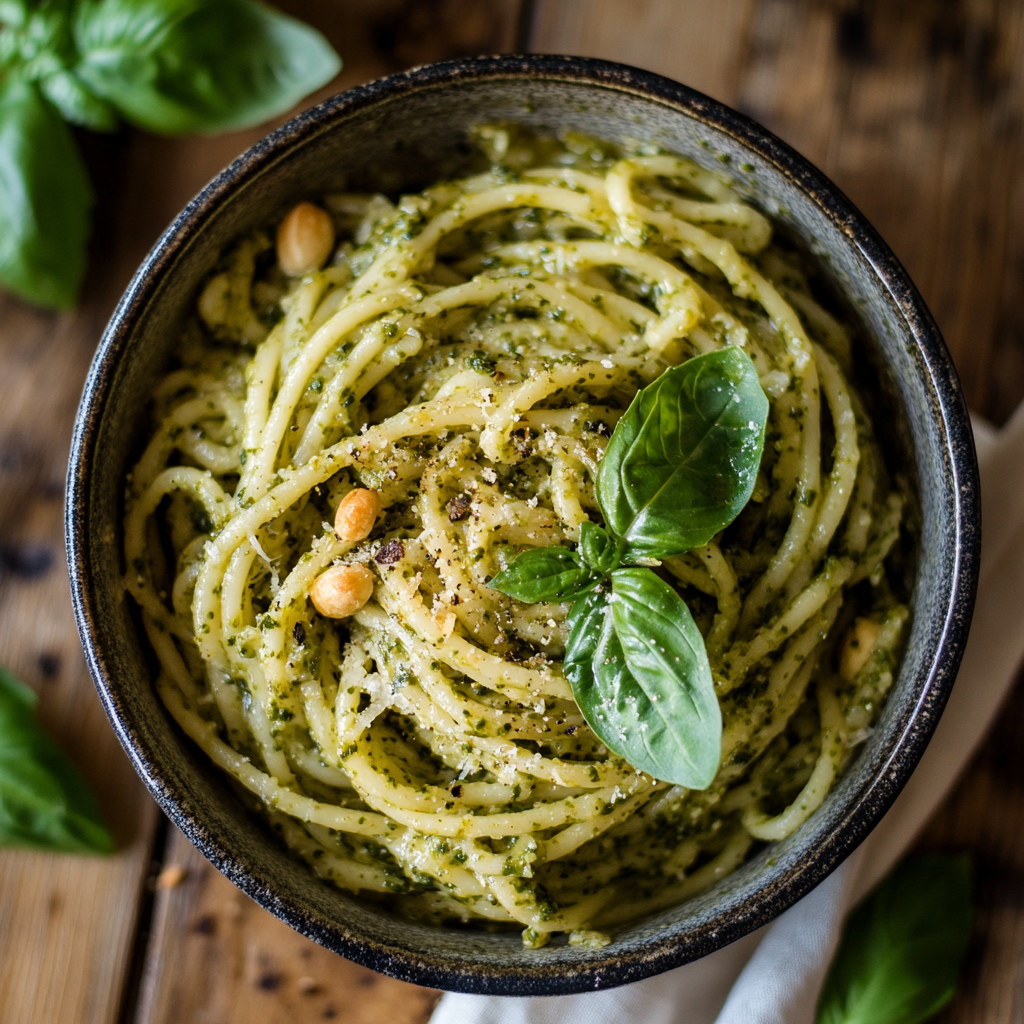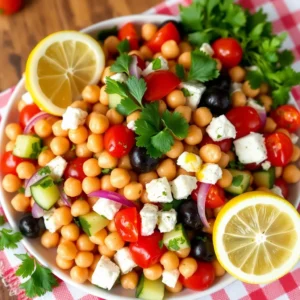Have you ever found yourself staring blankly into the refrigerator at 6 PM, wondering how to turn those random ingredients into something that doesn’t scream “I gave up”? I’ve been there more times than I care to admit! That’s when Homemade Pesto swoops in like a culinary superhero, ready to save dinner with its bright, herbaceous powers. This vibrant green sauce isn’t just gorgeous—it’s the secret weapon in my kitchen that turns the ordinary into extraordinary with minimal effort.
Why You’ll Love This Homemade Pesto
There’s something truly magical about watching a handful of simple ingredients transform into a sauce so packed with flavor that it makes even plain pasta feel like a special occasion meal. Store-bought versions just can’t compare to the vibrant color and fresh taste of homemade pesto that you whip up yourself.
What makes this pesto recipe particularly special is its flexibility. Running short on pine nuts? No problem! Substitute walnuts or even sunflower seeds. Need a dairy-free option? I’ve got you covered there too. This recipe bends to fit your pantry and dietary needs without sacrificing an ounce of flavor.
Plus, making pesto at home means you’re skipping all those preservatives and mysterious ingredients that lurk in the store-bought versions. Just clean, fresh flavors that you can feel good about feeding your family.
The History Behind Your Bowl
Before we dive into making this glorious green goodness, let’s take a quick moment to appreciate where it came from. Pesto has its roots in Genoa, Italy, where it was traditionally made using a mortar and pestle (hence the name “pesto,” which comes from the Italian word “pestare,” meaning “to pound”).
Traditional Genovese pesto features basil from the region of Liguria, which is said to have a particularly intense flavor thanks to the Mediterranean climate. While we might not all have access to authentic Ligurian basil, the beauty of making pesto at home is that you can create something delicious with what you have on hand.
Ingredients You’ll Need
Let’s gather our ingredients for this vibrant Homemade Pesto. Each component plays an important role in creating that perfect balance of flavors:
- 2 cups fresh basil leaves: The star of the show! Look for bright green leaves without any wilting or dark spots. If you’re growing your own basil (even in a small pot on your windowsill), this is the perfect way to use it.
- 1/4 cup pine nuts: These add a buttery richness that’s characteristic of traditional pesto. If they’re out of your budget (they can be pricey!), walnuts or almonds make excellent substitutes. For nut-free households, sunflower seeds work beautifully.
- 1/4 cup grated cheese: A hard, aged cheese like Parmesan adds that savory umami flavor that makes pesto irresistible. For my dairy-free friends, nutritional yeast creates a similar flavor profile.
- 2 cloves garlic: Fresh garlic provides that distinctive punch. Feel free to adjust according to your preference—more for garlic lovers, less if you’re planning on close conversations later!
- 1/2 cup extra virgin olive oil: Don’t skimp here! A good quality olive oil makes a noticeable difference in the final flavor.
- 1 tablespoon fresh lemon juice: This bright, acidic note balances the richness of the other ingredients and helps maintain that vibrant green color.
- Salt and pepper to taste: These final touches bring all the flavors together.
Step-by-Step Instructions for Perfect Homemade Pesto
1. Prep Your Ingredients
First things first, let’s get everything ready to go. Give your basil leaves a good wash and pat them completely dry. Water left on the leaves can dilute your pesto’s flavor and affect its texture.
Next, let’s toast those pine nuts (or whatever nuts/seeds you’re using). Pop them in a dry skillet over medium heat for 2-3 minutes, shaking the pan occasionally until they turn golden and release their nutty aroma. This simple step adds an incredible depth of flavor to your pesto that’s absolutely worth the extra few minutes.
Pro tip: Watch those nuts like a hawk! They can go from perfectly toasted to burnt in seconds. Trust me, I’ve ruined more batches than I care to admit while getting distracted by a text message!
2. Blend the Base Ingredients
Now for the fun part! Pull out your food processor (or blender if that’s what you have) and add your basil leaves, toasted nuts, grated cheese, and peeled garlic cloves.
Pulse the mixture several times until everything is finely chopped and well combined. You might need to stop occasionally to scrape down the sides with a spatula to make sure everything gets evenly blended.
Don’t have a food processor? No worries! You can use a mortar and pestle for a more traditional approach. It requires a bit more elbow grease, but there’s something wonderfully therapeutic about hand-grinding your pesto. Plus, some pesto purists swear the hand-ground texture is superior!
3. Add the Olive Oil
With your food processor running (or while continuing to grind with your mortar and pestle), slowly drizzle in the olive oil. This gradual addition is key to creating that perfectly smooth, emulsified texture that clings beautifully to pasta.
Continue processing until your pesto reaches your preferred consistency. Some people love a chunkier texture with more bite, while others prefer it silky smooth. There’s no right or wrong here—it’s all about what makes your taste buds happy!
If your pesto seems too thick, don’t worry. Simply add a tablespoon of water or a splash more olive oil to loosen it up.
4. Season to Perfection
Now it’s time to add the finishing touches that make this pesto sing. Stir in your fresh lemon juice, a pinch of salt, and a crack of black pepper.
Give it a taste (this is the chef’s privilege!) and adjust as needed. Need more brightness? Add another squeeze of lemon. Want more depth? A pinch more salt might do the trick. This is your creation, so make it perfect for your palate.
For an ultra-creamy variation, try stirring in a tablespoon of Greek yogurt. It adds a subtle tanginess and makes the pesto extra luscious.
5. Serve or Store Your Fresh Pesto
Congratulations! Your Homemade Pesto is ready to elevate practically anything in your kitchen. Toss it with hot pasta for an instant meal, spread it on sandwiches, drizzle it over eggs, or use it as a dip for fresh veggies.
If you’re not using it right away, transfer your pesto to an airtight container. To prevent the surface from browning, smooth it out with a spoon and pour a thin layer of olive oil on top. This creates a barrier that keeps oxygen away from your beautiful green creation. Properly stored in the refrigerator, your pesto will stay fresh for up to a week.
Want to enjoy your fresh pesto beyond that? Freeze it in ice cube trays for convenient, single-serving portions that can be thawed whenever you need a quick flavor boost. Once frozen, pop the cubes into a freezer bag where they’ll keep for up to three months.
Creative Ways to Use Your Homemade Pesto
Let’s be honest—pasta with pesto is a classic for good reason. But this vibrant green sauce has so much more potential! Think of Homemade Pesto as your culinary magic wand, ready to transform everyday ingredients into something special. Here are some of my favorite ways to use this versatile sauce beyond the pasta bowl:
Breakfast Game-Changer
Who says pesto is just for dinner? Swirl a spoonful into your scrambled eggs for a flavor explosion that will make you rethink your morning routine. Spread it on avocado toast and top with a poached egg for a café-worthy breakfast that takes just minutes to make. I’ve even mixed it into the batter for savory pancakes topped with a fried egg—trust me, it’s a revelation!
Sandwich Savior
Ditch the mayo and use pesto as your new go-to sandwich spread. It pairs beautifully with turkey, chicken, or roasted vegetables. My personal favorite: sourdough bread, Homemade Pesto, mozzarella, tomato, and a drizzle of balsamic glaze. It’s like summer captured between two slices of bread!
Pizza Night Upgrade
Swap traditional tomato sauce for a layer of pesto on your next homemade pizza. Top with mozzarella, cherry tomatoes, and whatever else your heart desires. The pesto adds an unexpected depth that will have everyone reaching for seconds.
Protein Partner
Brush pesto onto chicken breasts before grilling, or use it as a marinade for shrimp skewers. The herbs and oil infuse the protein with incredible flavor while keeping it moist. For a quick dinner win, spoon pesto over a piece of salmon before baking. The fish comes out perfectly tender with a flavorful herb crust that looks like you spent hours in the kitchen (when we know it took about 30 seconds of actual effort).
Vegetable Elevators
Boring steamed vegetables? Not on my watch! Toss roasted potatoes, cauliflower, or Brussels sprouts with a spoonful of pesto right after they come out of the oven. The residual heat will release all those amazing aromas and take your veggie side dish from “I guess I should eat this” to “Can I have seconds?”
Essential Kitchen Tips for Perfecting Your Pesto
Basil Best Practices
The secret to truly vibrant pesto starts with how you handle your basil. Try blanching your basil leaves for just 5-10 seconds before shocking them in ice water. This helps preserve that gorgeous green color, especially if you’re planning to store your pesto for a few days. Just make sure to dry the leaves thoroughly afterward!
And here’s a tip from my own garden mishaps: if your basil plant suddenly decides to grow faster than you can use it (they do that sometimes, don’t they?), don’t let it flower! Pinch off those flower buds to keep the leaves tender and flavorful. If it’s already flowering, harvest it anyway—just know your pesto might have a slightly more assertive flavor.
The Oil Situation
When adding your olive oil, temperature matters! Room temperature oil blends more smoothly than cold oil straight from the fridge. And here’s something many recipes won’t tell you: if your food processor or blender gets too warm during blending (which can happen!), it can affect the flavor of your olive oil. If you’re making a large batch, work in smaller portions or give your machine a break between pulses.
Storage Solutions
Pesto darkening in the fridge? Don’t panic! That’s just oxidation happening, and while it’s not as pretty, it still tastes great. Beyond the olive oil trick I mentioned earlier, try pressing plastic wrap directly onto the surface of your pesto before sealing the container. It’s like giving your pesto a little oxygen-proof blanket!
A Personal Pesto Story
I’ll never forget the summer I planted way too many basil plants in my backyard garden. What started as three innocent seedlings quickly grew into what my kids called “The Basil Jungle.” By July, I was making pesto by the gallon!
That was the summer I discovered just how versatile pesto could be. When you have that much of something, you get creative fast! I started freezing it in ice cube trays, giving jars to neighbors, and putting it on absolutely everything.
The funny thing? My pickiest eater, who normally inspects every green speck on her plate with FBI-level scrutiny, fell in love with my Homemade Pesto. Now she asks for “green spaghetti” at least once a week. Sometimes the wins in parenthood come from unexpected places—like a food processor full of basil and pine nuts!
Your Pesto Questions Answered
Can I make pesto without pine nuts?
Absolutely! While pine nuts are traditional, they’re also one of the pricier ingredients in pesto. Walnuts make an excellent substitute with their buttery texture and mild flavor. Almonds, cashews, or even sunflower seeds work beautifully too. Each alternative brings its own unique character to the pesto while maintaining that wonderful texture we all love. Just remember to toast whatever nut or seed you choose—it makes a world of difference in the final flavor!
How can I make my pesto last longer?
The best way to extend your Homemade Pesto’s life is proper storage. In the refrigerator, cover the surface with a thin layer of olive oil, which acts as a barrier against oxidation (that’s what causes the browning). For longer storage, freeze your pesto in ice cube trays or small containers. The frozen cubes are perfect for dropping into soups, sauces, or pasta whenever you need a quick flavor boost. Properly frozen, your pesto will maintain its quality for up to three months!
Can I make pesto dairy-free?
Yes! Pesto is incredibly adaptable to dietary restrictions. For a dairy-free version, simply omit the cheese and add nutritional yeast instead. Start with 2 tablespoons and adjust to taste—it provides that same savory, umami quality without any dairy. You can also add a tablespoon of white miso paste for an extra depth of flavor that works beautifully with the basil and garlic. Many of my friends who have made the switch say they don’t even miss the cheese!
Seasonal Variations to Keep Your Pesto Game Fresh
One of the best things about mastering Homemade Pesto is that the basic technique can be adapted to whatever is in season. When basil isn’t at its peak, try these delicious variations:
- Spring Pesto: Swap half the basil for tender baby spinach and add a handful of fresh mint.
- Summer Pesto: Use the traditional basil recipe, but add a few sun-dried tomatoes for a sweet-savory twist.
- Fall Pesto: Replace some of the basil with arugula and add toasted pumpkin seeds instead of pine nuts.
- Winter Pesto: Try a combination of parsley and kale with walnuts for a hearty cold-weather version.
Each seasonal variation keeps the spirit of pesto alive while celebrating what’s fresh and available. It’s like having a whole arsenal of sauces from one simple technique!
Bringing It All Together
There’s something deeply satisfying about creating Homemade Pesto from scratch. Unlike complicated kitchen projects that can leave you with more mess than motivation, pesto delivers maximum impact with minimal effort. It’s the kind of recipe that makes you feel like a culinary genius without requiring any fancy techniques or equipment.
Whether you’re making it to rescue a weeknight dinner, impress guests at a dinner party, or simply because your basil plant is threatening to take over your kitchen window, Homemade Pesto is a recipe that deserves a permanent spot in your cooking repertoire.
What I love most about this versatile sauce is how it connects us to a culinary tradition that’s centuries old while still feeling completely relevant to our busy modern lives. There’s something almost magical about creating something so vibrant and flavorful from just a handful of simple ingredients. It reminds us that good cooking doesn’t have to be complicated—sometimes the most straightforward recipes deliver the most extraordinary results.
So the next time you find yourself in a dinner rut or staring down a bundle of fresh basil at the farmers’ market, remember this Homemade Pesto recipe. In just 15 minutes, you can create something that will transform your meals for days to come. And isn’t that what good cooking is all about? Simple ingredients, treated with care, bringing joy to our tables and the people gathered around them.
Explore More Flavorful Creations
If you enjoyed this Homemade Pesto recipe, you might also love these other versatile sauces and condiments from our kitchen:
- Quick Romesco Sauce – Another versatile Mediterranean sauce that pairs beautifully with grilled vegetables and proteins.
- Homemade Marinara Sauce – A classic tomato sauce that’s perfect for pasta nights and so much better than store-bought versions.
- Garlic Herb Butter – The perfect companion to fresh bread and an amazing flavor booster for grilled steaks.
For more information about the health benefits of fresh herbs like basil, check out this informative article from Harvard Health Publishing.
To learn more about the traditional methods of making pesto in Genoa, Italy, this fascinating piece from Serious Eats offers wonderful insights into the authentic techniques.



